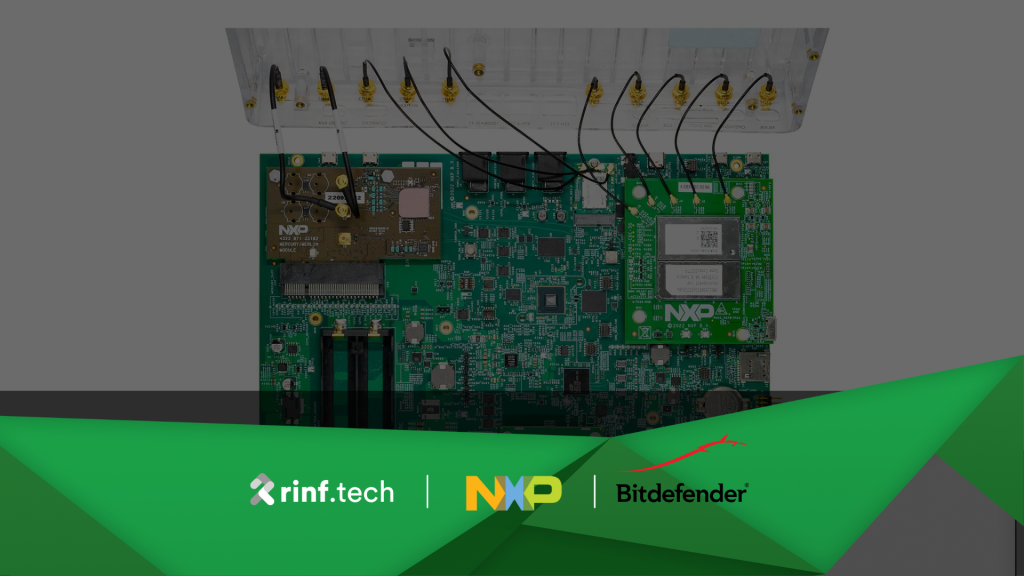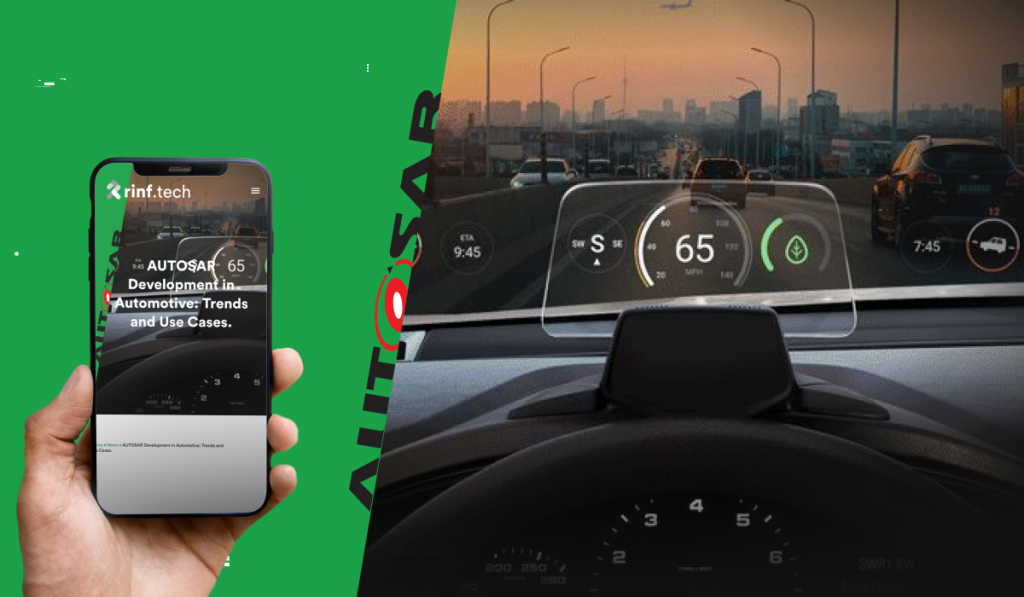
rinf.tech Joins Forces with NXP Semiconductors and Bitdefender to Enhance Connected Vehicle Cybersecurity via NXP OrangeBox
rinf.tech and NXP team up to develop a Connected Vehicle cybersecurity application backed by Bitdefender’s Security Agent.
McKinsey reports indicate that a mere 40% of R&D executives in the automotive sector who recognize software as a key disruptor believe their organizations are equipped to handle the forthcoming demands for innovation. The industry is undergoing a substantial transformation, and those who do not possess robust software development capabilities are at risk of incurring numerous challenges.
These include delays in delivering new features, cost overruns, and complications arising from software bugs and defects. Consequently, such entities will be trailing behind their more technologically adept competitors, including new market entrants who can deliver innovative automotive solutions more rapidly and cost-effectively.
Understanding and confronting these challenges is vital. For Tier 1 suppliers and OEMs, the implications of software complexity are far-reaching, impacting everything from production timelines to regulatory compliance and customer satisfaction. In a highly competitive and rapidly evolving market, effectively managing software development processes can become a significant differentiator.
This article aims to provide an insightful look into the best practices and methodologies that can help manage the intricate landscape of automotive software development.
The imperative need is the emergence of a novel operating model for automotive software to diminish complexity and increase efficiency. This model should focus on three pivotal aspects – the nature of the software being developed (What), the geographical and collaborative dynamics of development (Where), and the methodologies and infrastructures employed in the software’s lifecycle (How):
What is developed encompasses the conception of automotive software, including its architecture, design, and the specifications of the requirements. This field dictates the fundamental features and functions that the software must fulfill, aligned with industry needs and consumer expectations.
Where software is developed addresses the strategic distribution of development activities, considering the global dispersion of engineering talent and the formation of technology partnerships. This aspect involves coordinating various skills and resources to optimize productivity and innovation.
Developing software involves adopting a model that ensures flexible and scalable software creation, emphasizing refining development and testing processes, managing software performance effectively, and leveraging a robust tool infrastructure for support.
In adopting a new operating model, automotive companies must convert their software visions and business competencies into tangible and scalable architectures. They should implement smart product management, embrace automation, and detail feature requirements at the product, function, and module levels. This structured approach enables companies to thoroughly comprehend the variety of software that can generate tangible value, guiding the creation of software that meets current market demands and anticipates future trends and challenges.
In the face of evolving technologies and rising consumer expectations, the automotive industry confronts substantial challenges in software development. Addressing these complexities requires robust strategies to ensure quality, efficiency, and innovation in automotive software creation. Implementing Agile-at-scale or the V-model offers a dual advantage, integrating flexibility with structured verification to improve testing and development at every stage. Investing in advanced development tools equips teams with the means to streamline workflows and foster a culture of continuous learning and adaptation, which is indispensable in keeping pace with technological advancements.
Moreover, enhancing collaboration between multidisciplinary teams ensures a multifaceted approach to development, crucial for integrating complex systems like ADAS and infotainment seamlessly. These strategies, when executed effectively, can transform the landscape of automotive software development, leading to products that are not only reliable and user-friendly but also at the forefront of innovation.
Agile methodologies offer a flexible and iterative approach to software development, promoting adaptive planning, evolutionary development, and continual improvement. The V-model, on the other hand, is a more traditional and structured approach, emphasizing a sequential process of execution. Combined, these methodologies provide a comprehensive framework that supports flexibility and meticulous verification, ensuring thorough testing at each level of development.
One notable case study is the development of the Audio Manager Middleware by rinf.tech for an automotive Tier 1 client. The project involved developing and porting an Audio Manager Middleware component using C++, CANoe, Linux, and Python technologies. This middleware component is a Model-View-Controller (MVC) architecture controller, interfacing between the Human-Machine Interface (HMI) and the Audio Platform Component. Despite challenges in a distributed environment and unclear specifications, the team employed Agile methodology and ASPICE policies, achieving successful results like zero major defects at SOP delivery, 90% code coverage in unit tests, and the development of an automated regression testing framework.
A wide range of specialized tools are available in the automotive software development industry to make it easier to create, test, and manage software throughout its lifecycle. Integrated Development Environments (IDEs) support languages like C, C++, and Java and offer crucial interfaces for creating and debugging code, particularly for embedded automobile systems.
Examples of IDEs are Eclipse and Visual Studio. Version control across many car models and iterations requires configuration management systems like Git, SVN, and Mercurial. Model-based design tools – MATLAB/Simulink, dSPACE – simulate software-hardware interactions to optimize control system design. Furthermore, because automotive software upgrades and improvements are recurrent, continuous, and seamless software integration and deployment are supported by ongoing integration and continuous delivery (CI/CD) platforms such as Jenkins, Bamboo, and GitLab CI/CD.
Advanced development tools are revolutionizing automotive software creation by automating routine tasks to reduce errors and save developers time for more intricate challenges, with continuous integration tools exemplifying this by automating code testing and merging. Simulation and testing capabilities, like those in MATLAB/Simulink, enable early bug detection by replicating various driving conditions, streamlining the complexity that may arise later.
Enhanced collaboration features facilitate simultaneous editing, provide real-time feedback, and integrate communication, boosting productivity through improved team dynamics and minimizing redundant tasks. Additionally, these tools are designed to handle scaling effortlessly, which is critical for managing the growing complexity of automotive systems, ensuring that development remains manageable even as system complexities expand.
Static analysis tools like SonarQube and Coverity are invaluable in the safety-critical automotive software development industry. They help prevent bugs and security vulnerabilities and ensure that code complies with tight standards without requiring program execution. Equally important are requirements management systems such as DOORS and Jama Connect, which can easily handle many features and strict standards and ensure that all system needs are carefully documented and followed throughout the development cycle.
In addition, by replicating real-world hardware scenarios, Hardware-in-the-Loop (HIL) simulation tools allow the rigorous validation of complicated electronic control units (ECUs) without the significant costs and logistical difficulties associated with physical testing.
In the fast-paced world of automotive software development, where technology and best practices evolve rapidly, employees’ continuous upskilling and reskilling are beneficial and essential. As software becomes increasingly complex, with new languages, tools, and methodologies emerging, developers must constantly acquire new skills to remain effective. This is particularly crucial in the automotive industry, where integrating advanced driver-assistance systems (ADAS), electrification, and infotainment systems requires a workforce skilled in the latest technologies and methodologies.
Organizations should integrate professional development into their core strategy to foster a culture that prioritizes continuous learning. This can include allocating time during the workweek for employees to engage in learning activities, providing access to online courses or workshops, and supporting attendance at industry conferences. Mentorship programs within the company can also effectively transfer knowledge from experienced employees to newer team members and vice versa, as the interchange of expertise can provide fresh insights and innovations.
Collaborations with universities, technical institutes, and other educational entities can enrich the learning ecosystem of an automotive software company. Through partnerships, companies can gain access to cutting-edge research, tailor educational programs to fit specific industry needs, and even influence the curriculum to ensure that graduates are equipped with the relevant skills.
The complexity of modern automotive software systems requires a seamless integration of various skill sets and expertise. Cross-functional collaboration is the cornerstone of successful project execution in this sector. Integrating systems such as ADAS, connectivity modules, and electric vehicle management software requires expertise from software engineering, mechanical and electrical engineering, data science, and cybersecurity to create a cohesive product. Such an interdisciplinary approach ensures that software is developed with a comprehensive understanding of the vehicle’s architecture, addressing the nuances of user experience, safety, performance, and compliance with industry standards.
Improving communication and collaboration across multidisciplinary teams can be achieved through several strategic initiatives. Regular cross-departmental meetings and integrated team-building activities can foster a sense of unity and shared purpose. Utilizing collaboration platforms that consolidate communication, document sharing, and project tracking in one place can also enhance transparency and teamwork. Furthermore, implementing design thinking workshops that encourage creative problem-solving can benefit from diverse team inputs and result in solutions that are both user-centric and technically robust.
We at rinf.tech had the opportunity to help a global automotive Tier 1 client develop an Instrument Cluster for Mainstream Vehicles. This was an insightful example of effective cross-disciplinary interaction. The project was challenging due to the need to rectify 1600 defects, implement over 28 features, and ensure clear communication in a fully distributed environment. rinf.tech's team, in collaboration with the client's team, successfully delivered next-generation instrument clusters, emphasizing quality development and integration and enabling the client to focus on additional business opportunities.
Companies must prioritize standardization and modularity to reduce the complexity of automotive software architecture. An approach like this should work on different platforms to keep the software complexity under control. Original Equipment Manufacturers (OEMs) must move toward a service-oriented architectural style and emphasize differentiating software and hardware.
Automotive companies may isolate hardware functions and provide them to software services and functions through consistent application programming interfaces (APIs) used in the top layers of the architecture by putting in place a strong middleware layer. This method dramatically reduces design complexity while simultaneously promoting consistency across several platforms. It streamlines the overall development process by eliminating the need to design identical software components for various systems.
An essential first step in tackling the complexity of automotive software systems is adopting industry standards. ASPICE (Automotive Software Process Improvement and Capability Determination) and AUTOSAR (Automotive Open System Architecture) guarantee automotive software interoperability, quality, and safety. By adhering to these standards, developers can lessen the ambiguity that frequently makes software development more difficult by relying on a single language and set of expectations.
Furthermore, OEMs and Tier 1 suppliers can confidently expand their businesses by adhering to industry standards. They can incorporate new updates or features without upsetting the ecosystem and ensure that the software’s complexity doesn’t hinder innovation or maintenance. In the case of automotive software development, the combination of standardization and modularization is especially effective in cutting expenses and development time. While modularization offers a structural framework that promotes flexibility and reusability, standardization establishes the rules for interoperability and quality. Software development using a modular approach and established guidelines allows multiple teams to work on different components simultaneously, streamlining the integration process.
Big data and artificial intelligence (AI) / machine learning (ML) can significantly impact predictive analytics and problem-solving in automotive software development. The massive amounts of data produced by automotive systems are an invaluable source of information about user behavior, system functionality, and possible flaws. These data contain patterns that AI and ML algorithms are excellent at finding.
These patterns can then be used to improve features, support predictive maintenance, or even spark the creation of new services. Manufacturers can decrease downtime and increase customer satisfaction by anticipating problems before they happen. In addition to streamlining the diagnosis and maintenance procedure, implementing these technologies helps continuously enhance automotive software, resulting in smarter and more dependable vehicles.
Strong cybersecurity protections are critical as automobile systems grow networked and depend on software. Modern vehicles are more than mechanical structures. They are complex systems on wheels, with connectivity modules, sensors, and electronic control units (ECUs) facilitating internal and external communication. While this interconnection makes advanced functions like telematics services and autonomous driving possible, it also gives hackers access to various attack paths.
Automotive software developers must prioritize security because cybersecurity breaches can cause everything from privacy violations to safety hazards. ‘Security-by-design’ means cybersecurity is built into the development process, not added on after. This strengthens the vehicle’s defenses against known and unknown cyberattacks. Security considerations are incorporated throughout the development process when security-focused agile methods are included or approaches like Security Development Lifecycle (SDL) are employed.
Regular security training for developers should be implemented with this strategy to foster an attitude that security is everyone’s responsibility. The automotive industry may implement technologies and procedures to reduce cybersecurity threats. Including frameworks like AUTOSAR, which has security-specific modules, can offer a standardized method for developing safe systems. Fundamental techniques include secure coding, which involves following coding guidelines to avoid vulnerabilities. Furthermore, ECUs can employ technologies like Hardware Security Modules (HSMs) for cryptographic and secure key storage.
A robust testing and validation framework is the cornerstone of any automotive software’s dependability and security. It is impossible to overstate proper testing’s importance in an industry where failure can lead to serious safety consequences. An extensive regimen of virtual and physical tests is required to mimic various operating circumstances and probable losses.
Advanced techniques and tools are integral to executing comprehensive software testing. The automotive industry utilizes various testing methods, such as unit testing, integration testing, system testing, and acceptance testing, each targeting different levels of the software stack. Tools that support these methods range from automated testing frameworks to sophisticated simulation environments. For instance, Hardware in the Loop (HIL) testing allows the software to be tested against a simulation of the actual hardware, enabling the detection of defects that may not be evident in a software-only environment.
Additionally, model-based testing can improve the efficiency and coverage of tests by automating the process of creating test cases from system models. Robot testing is another factor in the comprehensive validation of the user interface and interaction processes, which involves using tools such as Model-Based Testing Tool.
Enterprise robots are a viable option for companies seeking the highest level of automation in automotive software testing. In addition to saving money and streamlining procedures, this will also reduce the testing load on developers. The robot MATT by our robotic scale-up Adapta is successfully used for testing infotainment solutions by some of the top OEMs and Tier 1 companies.
Digital twins and other types of simulation software are essential to the automotive software development process because they provide advantages that lead to improved results. Through simulation, automotive systems can be tested virtually in various scenarios that could be too expensive, time-consuming, or hazardous to try in real life. It is essential in checking and validating automotive software, ensuring the system functions as planned before building an actual prototype.
Simulation tools, for instance, can simulate a vehicle’s dynamics under different circumstances, enabling engineers to evaluate how the software reacts to inputs and external factors. This considerably reduces the time to market for new inventions and lowers development expenses.
While simulation provides a controlled environment for initial testing, the ultimate goal is ensuring the software performs reliably in the real world. This requires a seamless integration of simulation tools with real-world testing. Developers can calibrate their models by comparing simulated outcomes with actual test data for greater accuracy. This hybrid approach allows teams to refine their systems under a virtually limitless combination of scenarios and verify predictive accuracy with targeted physical tests. For instance, simulated crash tests can be cross-referenced with crash test data to improve safety features. At the same time, fuel consumption models can be validated against field data to enhance efficiency predictions.
It takes a comprehensive approach that integrates agile methods, cutting-edge tools, continuous learning, collaborative efforts, and robust testing frameworks to navigate the complexity of automotive software development. By adopting these tactics, OEMs and Tier 1 suppliers may put themselves at the forefront of innovation and guarantee that their products fulfill the demanding standards set by the market for functionality, safety, and dependability.
Embarking on this path demands a paradigm shift in company culture and procedures rather than just adopting techniques and tools. The challenge for original equipment manufacturers (OEMs) and Tier 1 suppliers is establishing an environment that supports technical agility and makes continuous improvement a core value rather than simply an objective.

rinf.tech and NXP team up to develop a Connected Vehicle cybersecurity application backed by Bitdefender’s Security Agent.

The article provides an overview of use cases as well as advantages and disadvantages of using AUTOSAR for automotive software development.

This article addresses how HIL Testing works and helps bridge the gap between the automotive software component models and an actual object like a car.
Copyright © 2023 rinf.tech. All Rights Reserved.
Terms & Conditions. Cookie Policy. Privacy Policy.
Politica Avertizari de Integritate (RO)